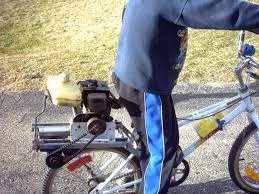In 1962, my uncle had a "Whiz", German or English motorized bike. The engine was small, probably less than 50cc. The gas engine was in the middle and it was coupled to the the rear wheel via chain. The manual pedal was operative and my uncle would push with his left leg, then pedal a short distance, then I would hear the purrrhh. Off he goes. And sometimes, he came home just pedaling:out of gas! I thought that was fantastic to be able to pedal home when out of gas or faulty engine. Then I saw advertize in our local magazine, an engine to be clamped on the frame of a regular bike. It was Taiwan made. The brand was TAS. Then the Velosolex. I have one. The engine was front mounted and had a small tank beside it, headlight and all. So compact. The engine had a lever to disengage it from the front tire. Very ingenious. The pedal system with its chain and sprockets to the rear is totally independent. The way to run it is to pedal it like a bike and when momentum is achieved, release the lever to engage the engine which will be initially started by the moving bike and will run the bike when started. The small engine has a roller underneath which rubs on the tire. This motorized bike had no gear shifts.
A DISCUSSION OF PRINCIPLES INVOLVED
Speed and torque are inversely proportional. Grandma's sewing machine is a perfect example of speed and torque. There is the big wheel turning the small wheel. The powerful legs pedals the big wheel. Torque is converted to speed. So with the bike. The big pedal wheel of about 8" in diameter spins a 2" sprocket in the rear. A gear shift system is nothing but different sizes sprockets combination. The most powerful combination is the smallest drive sprocket at the pedal spinning the biggest rear sprocket. for speed, it is the other way around.
Engines can develop speed and by speed reduction, torque is elevated. In a regular commercial motorcycle, these is all done inside a transmission box. The kuliglig around Metro Manila is the ingenious way torque is achieved with industrial engines using belts and pulleys. I first saw this in our lawnmower in the U.S. when I was 17. And the clutch system is just an ingenious way of loosening or tightening the belt..
But the kuliglig still turned the wheel via a sprocket in the center of the wheel. Velosolex took advantage of the fact that the bike's wheel was like a big pulley itself. So, if a small roller coming out of the engine's shaft is made to turn a big wheel, then there is no need for belts and pulleys to reduce the speed and increase the torque.
In the U.S. and I am sure in many other countries, the Velosolex was regained popularity. We will upload some homebuilts here.
